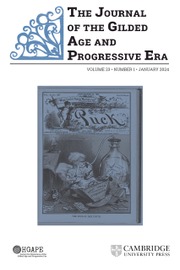It is hardly controversial to claim that James Abram Garfield was one of the United States’ lesser-known presidents. Nevertheless, Garfield spent the majority of his adult life in the public eye: as an Ohio state senator, a Major General in the Union Army, a Congressman, U.S. Senator-elect, and, ultimately, the country’s second martyred president. In a political moment defined by corruption, railroads, tariffs, a divided Republican Party, and racial and labor unrest, Garfield’s life offers insight into the height of Gilded Age Republicanism. Few full biographies exist, however, with Allan Peskin’s Garfield: A Biography (1978) being the most recent prior to C. W. Goodyear’s President Garfield: From Radical to Unifier. Written for a popular audience, Goodyear’s book argues that Garfield’s embrace of “undramatic efficiency” allowed him to move away from Civil War radicalism to clinch the 1880 Republican nomination despite a deep divide within the Republican Party (8). Goodyear concludes that Garfield’s assassination ostracized the Stalwart faction of the party, who strongly opposed any changes to the spoils system, and created a “calmer public discourse and cleaner government” (13).
Goodyear structures this biography in four parts. Part I, “The Wilderness,” describes Garfield’s upbringing, from his birth in a log cabin to his times as a canal boy, a preacher, a school principal, a lawyer, and, finally, a state senator. The second part, “The War,” narrates Garfield’s days as a general, but spends little time considering how this experience may have impacted his leadership style following the war. The largest portion of the book, Part III, “The House,” describes Garfield’s career in Congress, where he played a role in the “unexceptional” Crédit Mobilier scandal (243). Goodyear applauds Garfield’s amendments to the Ku Klux Klan Act (1871), which gave “proper balance of governmental powers in the Republic” (231), and admonishes him for helping to force the Salish peoples of the Upper Northwest onto reservations (238–39). Part III ends, predictably, with the run-up to the 1880 Republican presidential nomination, while Part IV, “The Presidency” picks up at the 1880 Chicago convention.
In what is undoubtedly the best written and researched section, Goodyear describes Garfield’s approach to speaking to the masses from his front porch during the 1880 election as an act that “revolutionized American campaigning” (377)—although it should be noted that presidential candidate Stephen Douglas campaigned in person as early as 1860—and claims Garfield was the first candidate to “ever invite the industrial mega-rich … into presidential politics” (391). Goodyear describes Garfield’s presidency, like his campaign, as “era-defining.” Garfield weakened the Stalwart Republicans and their leader Roscoe Conkling by nominating one of their foes to the influential patronage post of New York City Collector of the Port (443). Goodyear concludes the book with Garfield’s 1881 assassination, using newspaper articles to show the extent of the nation’s mourning for the martyred president.
Goodyear brings up new ideas for researchers of the twentieth president, but stops short of answering them. The book is scant on detail in the realms of Indigenous, Black, and women’s history; it instead focuses entirely on Garfield. Garfield’s family, mother, and mistresses also fall to the wayside due to the single-minded vision of this book, which follows the lead of the nineteenth-century “Great Man” biographies. This book is burdened by unreasonably long quotations from primary sources and insufficient analysis of them. It fails to offer significant insight into the mind of Garfield, or any major critique of Garfield’s life choices—apart from his dealings with the Salish peoples, where Goodyear directs readers to consult “the excellent work of Salish historians” (238) without citing any.
President Garfield’s greatest weakness is lack of engagement with professional scholarship. The author calls Garfield’s ascent to the presidency “miraculous” and paints parts of his life as the work of providence rather than actions taken by individual actors (14, 28, 38). These ideas mirror Goodyear’s choice of sources, the bulk of which are late nineteenth- and early twentieth-century works such as George Clemenceau’s American Reconstruction (1928), Carl Sandburg’s Abraham Lincoln: The Prairie Years (1926) and Abraham Lincoln: The War Years (1939), as well as hagiographies written immediately after Garfield’s death.
Engagement with more contemporary scholarship might have limited persistence of common myths regarding Reconstruction and the Gilded Age. For example, when discussing the election of 1876 and the so-called Compromise of 1877, Goodyear relies heavily on C. Vann Woodward’s disputed Reunion and Reaction (1951) and Roy Morris Jr.’s Fraud of the Century (2003). Goodyear repeats the tired myth that it was a group of southern Democrats who wished to halt the filibuster (302–03) and that Rutherford B. Hayes unilaterally forsook African Americans to placate southern Democrats (306–07). He also asserts that historians continue to debate whether the Wormley House Conference “accomplished anything” (304), even though scholars such as Michael Les Benedict have essentially settled that historiographical debate.
Contrary to Allan Peskin’s conclusion that Garfield’s life was one of contradictions, and his accomplishments neither bold nor heroic, Goodyear’s Garfield is two-dimensional and lacks context. In this way, Goodyear has not written a twenty-first-century scholarly biography, but rather a twenty-first-century synthesis of nineteenth-century hagiographies suffused with insights from early twentieth-century scholarship. President Garfield, in short, is a simple retelling of the life of America’s twentieth president. Although it does bring some more contemporary questions to the life and times of James A. Garfield, scholars continue to await a more original biography to replace Peskin’s standard.


